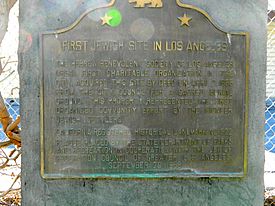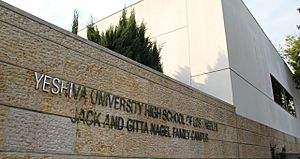History of the Jews in Los Angeles facts for kids
Quick facts for kids Jews in Los Angeles |
|
|---|---|
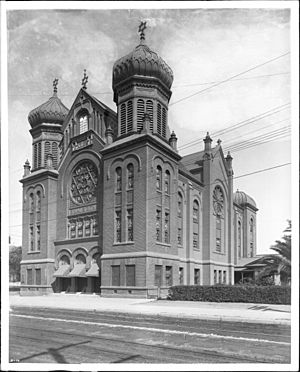
Congregation B'nai B'rith, the first synagogue established in Los Angeles in 1869, photo circa 1900
|
Jews make up a big part of the population in Los Angeles. About 17.5% of the city's people are Jewish. In LA County, about 7% of people are Jewish. This makes Los Angeles home to one of the largest Jewish communities outside of New York City and Israel.
As of 2015, over 700,000 Jewish people lived in County of Los Angeles. More than 1.2 million Jews lived in California overall. Jewish people started moving to Los Angeles when it was part of Alta California (a Mexican state). Many more arrived from the late 1800s until today. The Jewish population grew from about 2,500 in 1900 to 700,000 in 2015. This large community has greatly influenced the culture of Los Angeles.
The number of Jewish people in Los Angeles has grown a lot recently. Many have moved from the East Coast of the United States. Others have come from Israel, France, the former Soviet Union, the United Kingdom, South Africa, and Latin America. Also, the Hasidic and Orthodox communities, which are about 10% of the Jewish population, have a high birth rate.
Contents
Jewish Population in Los Angeles
As of 2020, about 530,000 Jewish people live in Los Angeles. A study by the Steinhardt Social Research Institute shows that Los Angeles County has the second-largest Jewish population in the U.S. Only New York City has more. Los Angeles is also the fifth largest Jewish city in the world.
A 2021 study found that about half of Jewish homes in Los Angeles include an immigrant or someone whose parent is an immigrant. These families come from places like Iran, Israel, Russia, the former Soviet Union, Latin America, and Europe. Israeli Americans and Latino Jews are often younger than the general Jewish population in Los Angeles. Persian and Israeli-American Jews often feel a strong connection to their Jewish community.
Jewish Roots in Los Angeles
Persian Jews
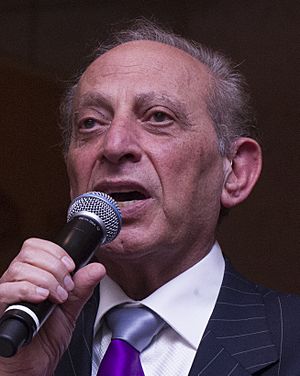
The Los Angeles area has the largest Persian Jewish population in the U.S. There were about 50,000 in 2008.
The Iranian American Jewish Federation (IAJF) helps the Iranian Jewish community in Los Angeles. It works to fight against hatred towards Jewish people. It also protects Iranian Jews and helps those in need.
Many Persian Jews moved to Beverly Hills because of its good schools and strong Jewish community. A business area in the city became known as "Tehrangeles." This was because many Persian people owned businesses there. After the 1979 Iranian Revolution, about 30,000 Iranian Jews settled in Beverly Hills. They were able to adapt quickly because they were well-educated and had business experience.
At first, there were some small problems between Persian Jews and Ashkenazi Jews in synagogues. This was due to cultural differences. But these issues mostly disappeared by 2009.
Israelis

Los Angeles is home to the largest group of Israelis outside of Israel. More than 250,000 Israeli Americans live in the Los Angeles Metropolitan Area. This is according to the Israeli American Council.
The Israeli community in Los Angeles is mostly found in the San Fernando Valley and the Westside of Los Angeles. Areas like Encino and Tarzana are known for their large Israeli populations. Many Israeli Americans are second or third-generation Americans. Others are newer immigrants who started moving to Los Angeles in the 1970s. The Israeli American community has become important in local business and culture. Los Angeles has the world's first Israeli Community Center (ICC). It is similar to a JCC and is located in the San Fernando Valley.
Russian Jews
Los Angeles has about 25,000 Russian-speaking Jews. It has the second-largest population of Russian Jews from the former Soviet Union in the United States, after New York. Russian-speaking Jews make up 10% to 15% of the local Jewish population. Many live in West Hollywood.
Latino Jews
As of 2006, about 11,000 Latino Jews lived in Los Angeles. Many of them lived in the West Hills area.
Moroccan Jews
The Moroccan Jewish community in Los Angeles is one of the largest in North America. About 10,000 Moroccan Jews live in the Los Angeles area. Most are in Pico-Robertson, North Hollywood, and Beverly Hills. Many came after World War II. Others arrived later from Israel or France. Most follow Orthodox Judaism. Some also belong to Haredi, Reform, and Conservative Judaism groups. The community has its own synagogues and a community center.
Rhodeslis
The Los Angeles area is home to about 900 Rhodeslis (Jews from the island of Rhodes). The first Rhodesli families settled in Ladera Heights in the early 1900s. They came to Los Angeles to escape challenges and find new opportunities. Ladera Heights was the center of their community for many years.
Rhodeslis spoke Ladino at home. They built their own synagogue, the Sephardic Hebrew Center. This synagogue later joined with Sephardic Temple Tifereth Israel in 1993. In the 1960s and 70s, Rhodeslis began to move out of Ladera Heights. Today, Rhodeslis live all over LA County. Some worry about losing their unique culture and traditions. Older members still speak Ladino.
Since the mid-1900s, the Rhodesli community in Los Angeles has had a special tradition. Every summer, about 40 Rhodeslis take a ferry to Catalina Island. This trip helps them connect with their shared culture and history. They visit Catalina Island because it reminds them of Rhodes, which is also an island near a larger landmass (Turkey).
The island of Rhodes was once home to an important Sephardic Jewish community. They had their own unique culture. Jews of Rhodes, called Rhodeslis, lived peacefully under Ottoman rule. They kept the old form of the Ladino language. This language came with them after the Inquisition and their expulsion from Spain in 1492.
In 1944, the Nazis invaded Rhodes. Many Rhodes Jews were sent to concentration camps. Many Rhodeslis who survived the Holocaust and fled World War II moved to Los Angeles. They chose Los Angeles because there was already a Rhodesli community there. Also, the area's Mediterranean climate and coastline reminded them of their home.
Yemenite Jews
When Israelis started moving to Los Angeles in the mid-1900s, some Yemenite Jews from Israel came too. They mostly settled in Pico-Robertson, Santa Monica, and Encino. You can find several restaurants with Yemenite Jewish food in these areas. There are also several synagogues that follow Yemenite traditions. The most famous is Tifereth Teman on Pico. Many Yemenites also go to synagogues for the general Mizrahi Jewish community.
In 1964, a group of Yemenite Jews started meeting to pray in their homes. They used the Yemenite dialect of Hebrew. For 18 years, they did not have their own synagogue. In 1986, they bought a house and turned it into Tifereth Teman, the first Yemenite synagogue in Los Angeles. Some neighbors were not happy about this. The synagogue later moved to a different building with the right zoning.
South African Jews
As of 1986, over 500 South-African Jews lived in Irvine, in Orange County. Most South African Jews in Los Angeles are Orthodox. They attend religious services at an Orthodox synagogue or a Chabad center.
History of Jews in Los Angeles
The history of Jews in Los Angeles includes many important contributions. They have helped shape the arts, culture, science, education, and politics. The first known Jewish person, Jacob Frankfort, arrived in 1841. He was a tailor from Germany.
1800s
In 1841, Jacob Frankfort came to the Mexican Pueblo de Los Ángeles. He was the city's first known Jewish resident. When California became a U.S. state in 1850, the census showed eight Jews living in Los Angeles.
Morris L. Goodman became the first Jewish Councilman in 1850. Solomon Lazard, a merchant, served on the council in 1853. He also led the first Los Angeles Chamber of Commerce. Arnold Jacobi was a council member from 1853 to 1854.
Joseph Newmark, a religious leader, started holding the first informal Sabbath services in Los Angeles in 1854.
In 1854, Joseph Newmark helped create the Hebrew Benevolent Society. This group helped the growing Jewish community. Their first big effort was getting a cemetery site from the city in 1855. This cemetery was in Chavez Ravine. Today, a marker for the "First Jewish site in Los Angeles" is near Dodger Stadium. In 1910, the bodies were moved to the Home of Peace Cemetery in East Los Angeles.
The oldest Jewish group in Los Angeles started in 1862. It was a Reform group, and it is now the Wilshire Boulevard Temple congregation.
In 1868, Isaias W. Hellman and his partners started the Farmers and Merchants Bank. He also helped create the new University of Southern California in 1879. He served on the board of the University of California until 1918.
1900s
From 1900 to 1926, there was no single Jewish neighborhood. About 2,500 Jews lived "downtown." This area included Temple Street and Central Avenue.
In 1900, there were 2,500 Jews in Los Angeles. This number grew to 5,795 in 1910, 10,000 in 1917, and 65,000 by the mid-1920s.
In 1902, the Kaspare Cohn Hospital was founded. It later became Cedars of Lebanon Hospital and then Cedars-Sinai Medical Center.
In 1906, the Sinai Temple was formed. It was the first Conservative Jewish group in Los Angeles. In 2013, the building became the Pico Union Project, a center for different faiths and cultures.
In the 1920s, many Jewish immigrants moved to Los Angeles. Boyle Heights became home to the largest Jewish community west of Chicago. In 1920, there were 1,842 Jewish families in Boyle Heights. By 1930, almost 10,000 Jewish families lived there.
In 1920, the Hillcrest Country Club opened. It was a club for the Jewish community. Other clubs at the time often did not allow Jewish members. The club was famous for its "Comedian's Round Table." This group included Jewish comedians like Jack Benny and George Burns.
In 1925, an Orthodox synagogue, Beth Jacob Congregation, was founded. It is now the largest Orthodox synagogue in the Western United States.
In 1927, I.M. Hattem, a Sephardic Jew, opened America's first supermarket. It was a new idea to have many products like meat, produce, and baked goods all in one store.
The first Sephardic synagogue in Los Angeles, now called the Sephardic Temple Tifereth Israel, opened in 1932.
In 1935, a large meeting was held to protest how Jews were treated in Germany. In 1936, the Los Angeles Jewish Community Council was formed. This is now the Jewish Federation Council. By 1940, Los Angeles had the seventh-largest Jewish population in the U.S.
After World War II, many Jews moved to Los Angeles. About 2,000 Jews settled there each month in 1946. By 1950, almost 300,000 Jews lived in Los Angeles. By the end of the 1950s, over 400,000 Jews lived there. This was about 18% of the total population. By the end of the 1970s, over 500,000 Jews lived in Los Angeles.
In 1989, about 1,500 Soviet Jews arrived in Los Angeles. By 2021, Russian-speaking Jews made up 10-15% of the local Jewish population.
Jewish people have helped create many businesses and cultural places in Los Angeles. This includes the entertainment, fashion, and real estate industries.
2000s
After the 2013 mayoral election, city councilman Eric Garcetti became the city's first elected Jewish mayor. He was re-elected in 2017.
Jews in the Entertainment Industry
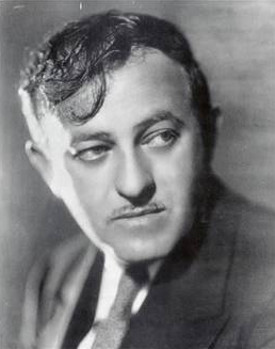
Jewish people played a big part in starting the film industry in Hollywood in the early 1900s. Studios like Metro-Goldwyn-Mayer, 20th Century Fox, Columbia Pictures, Paramount Pictures, Universal Pictures, and Warner Bros. were all started and led by Jews. Most of them were immigrants or children of immigrants from Germany and Eastern Europe.
Neal Gabler wrote in his book An Empire of Their Own that the movie industry was open to Jews. Other jobs and businesses often kept them out. Gabler said that because of challenges they faced, Jews could create "an America where fathers were strong, families stable, people attractive, resilient, resourceful, and decent." Hollywood helped define the 20th Century American Dream.
Some people criticized the movie industry, saying it was a Jewish plan to harm "Christian" and "American" values. This was especially true during a time of many immigrants. These ideas about Jewish control are part of anti-Jewish thinking. The role of these "Hollywood Jews" has been discussed for years. Most of them tried not to show their Jewish identity. They wanted to fit in with the non-Jewish white community.
Some African Americans were upset by negative images of Black people in movies. They also noted the small number of Black directors and producers. Hollywood leaders said there was no conspiracy. They said Jews in the industry supported civil rights and more Black participation.
Jewish Communities in Los Angeles
Since the late 1960s, Orthodox Jews have increasingly settled in Hancock Park. Today, Hancock Park is home to a growing Hasidic Jewish population. Many Hasidic groups are represented there. Also, a community of Haredi non-Hasidic Jews (called Litvish or Yeshivish) lives in the area. There are also some Modern Orthodox Jews.
As of 1990, most Iranians in Beverly Hills were Jewish. Many Iranian restaurants and businesses were set up on Westwood Boulevard.
Jewish people have also moved to the San Fernando Valley and Thousand Oaks.
When Jews first settled in Los Angeles, they lived in the Downtown area. As the city grew, they moved to Eastside Los Angeles. The Los Angeles Jewish community formed in the Boyle Heights area, Temple Street area, and Central Avenue area between 1910 and 1920.
In the 1920s, Boyle Heights was seen as the center of the Jewish community. By 1930, almost 10,000 Jewish families lived there.
Since 1953, every representative for the City Council's 5th District has been Jewish.
By the 1980s, many Jews moved to the Pico-Robertson neighborhood. They joined German Ashkenazi Jews who settled there in the 1910s. They also joined newer Iranian Jews who had left Iran. Today, Pico-Robertson has a large Jewish community. It has over six major Jewish private schools and more than thirty kosher restaurants. There are also over twenty synagogues and five mikvahs (ritual baths).
As of 2020, about 87,000 Jews were estimated to live in Orange County.
Jewish Media in Los Angeles
Film
Today, the role of Jews in Hollywood is less central. However, individual Jewish people are still leaders in the industry.
Television
Los Angeles is home to one of only two Jewish television channels, Jewish Life Television. It broadcasts worldwide from a studio in Sherman Oaks. Also, JBS, a Jewish channel from New York, shows weekly Shabbat services from Sinai Temple in Westwood. Both channels are available through local cable.
The Jewish Journal of Greater Los Angeles is a local Jewish newspaper. It is known for interviews with Jewish celebrities and important people in the Los Angeles Jewish community. It also covers local Jewish culture and news about Jewish communities around the world and in Israel. The Jewish Journal is the largest Jewish publication outside of Israel. It is given out across North America. In September 2020, the print version stopped due to the COVID-19 pandemic. It is now only online.
Many other Jewish magazines and newspapers exist in Los Angeles. They are printed in languages like English, Yiddish, Hebrew, French, Farsi, and Spanish.
Radio
Southern California has one Jewish radio station. Kol Haneshama broadcasts 24 hours a day from the Ateret Israel synagogue in Pico-Robertson. Some local stations also play Israeli Army Radio. This is for the large Israeli-American population in the city.
Jewish Cuisine in Los Angeles
When Jewish people moved to Los Angeles, many opened delicatessens. By 2013, some delis had closed. This was due to older customers, new dining options, and economic reasons.
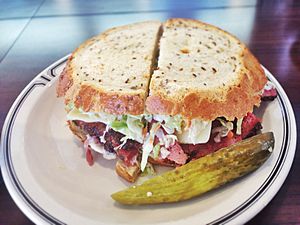
The Jewish food in Los Angeles was like that in New York for a long time. But later, more restaurants opened serving Persian Jewish and Israeli cuisine. These new influences, along with Californian cuisine and fresh local produce, have created a unique Los Angeles Jewish food style. There are also many kosher restaurants in Los Angeles. They serve Jewish, Persian, Israeli, Moroccan, Yemenite, Chinese, Mexican, and Italian foods.
Some famous Jewish restaurants in Los Angeles include:
- Canter's Delicatessen
- Langer's Delicatessen
- Nate 'n Al of Beverly Hills
- Wexler's Deli
- Bavel
- The Milky Way, a kosher dairy restaurant in Beverly Grove owned by Steven Spielberg
- Western Bagel
- Bibi's Bakery
- Harissa Restaurant and Bakery – Pico-Robertson
- Pizza World, Vegetarian, Mexican and Italian - Pico-Robertson
- Jeff's Gourmet Sausage Factory – Pico-Robertson
- Beverly Hills Kosher Thai
Jewish Education in Los Angeles
Milken Community High School is in Bel-Air. It is connected to Stephen S. Wise Temple, a Reform congregation.
Sinai Akiba Academy is a private elementary school in Westwood. It is connected to Sinai Temple, a Conservative congregation.
In the Fairfax District, there are several Orthodox Jewish schools. Yeshiva Rav Isacsohn/Toras Emes Academy is a Haredi school. Mesivta Los Angeles is a Hasidic Yeshiva. Yeshiva Gedolah of Los Angeles is an all-boys Litvish Haredi Yeshiva. Bais Yaakov of Los Angeles is a Haredi girls-only high school. Bnos Devorah High School is a small Hasidic girls-only school. Yavneh Hebrew Academy is a Modern Orthodox K-8 school. Shalhevet High School is a Modern Orthodox co-ed high school.
There are also several Orthodox Jewish schools in the Pico-Robertson neighborhood. Harkam Hillel Hebrew Academy is a Modern Orthodox K-8 school. Yeshiva University High Schools of Los Angeles is Modern Orthodox and has separate campuses for boys and girls. Mesivta Birkas Yitzchok is a Haredi boys-only high school.
Jewish schools in the San Fernando Valley include Valley Torah High School, Emek Hebrew Academy, Einstein Academy, Abraham Joshua Heschel Day School, and Kadima Hebrew Academy.
Rohr Jewish Learning Institute works with Chabad throughout Los Angeles.
American Jewish University is located in Bel Air, Los Angeles.
Notable Jewish Residents
- 24kGoldn (rapper)
- J. J. Abrams (filmmaker)
- Dianna Agron (actress)
- Jason Alexander (actor)
- Judd Apatow (filmmaker)
- Alan Arkin (actor)
- Irving Azoff (manager, executive)
- Sacha Baron Cohen (comedian, actor)
- Benny Blanco (music producer)
- Rachel Bloom (screenwriter, actress)
- Amir Blumenfeld (comedian)
- Alison Brie (actress)
- Max Brooks (author)
- Mel Brooks (filmmaker, actor, comedian)
- Lizzy Caplan (actress)
- Emory Cohen (actor)
- Flora Cross (film actress)
- Billy Crystal (comedian)
- Larry David (actor, comedian)
- Sammy Davis Jr. (actor, member of the Rat Pack)
- Jimmy Delshad (Mayor of Beverly Hills)
- Kat Dennings (actress)
- Kirk Douglas (actor)
- Michael Douglas (actor)
- Drake (rapper, actor)
- Howard Deutch (filmmaker)
- Zoey Deutch (actress)
- Bob Dylan (musician, poet)
- Zac Efron (actor)
- Jesse Eisenberg (actor, director)
- Doug Emhoff (entertainment lawyer and husband of Vice President Kamala Harris)
- Nora Ephron (writer, director)
- Susie Essman (comedian)
- Jon Favreau (writer, actor, filmmaker)
- Beanie Feldstein (actress)
- Mike Feuer (City Attorney of Los Angeles)
- Isla Fisher (actress)
- Gal Gadot (actress and former Miss Israel)
- Ron Galperin (first openly gay City Controller of Los Angeles)
- Jeff Garlin (actor, comedian)
- Jackie Goldberg (politician)
- Jake Gyllenhaal (actor)
- Maggie Gyllenhaal (actress)
- Marvin Hier (rabbi)
- Jonah Hill (actor)
- Rashida Jones (actress)
- Jenji Kohan (TV show producer)
- Zoe Kravitz (actress)
- Nick Kroll (actor, comedian)
- Norman Lear (showrunner)
- Dan Levy (actor, comedian)
- Eugene Levy (actor, comedian)
- Jane Levy (actor)
- Jerry Lewis (actor, comedian)
- Richard Lewis (actor, comedian)
- Lil Dicky (rapper, comedian)
- Michael Milken (financier)
- Daniel Pearl (journalist) - Encino
- Judea Pearl (professor and father of Daniel Pearl)
- Natalie Portman (actress)
- Rob Reiner (actor, filmmaker)
- Shari Redstone (executive)
- Sumner Redstone (executive)
- Melissa Rivers (actress, producer)
- Seth Rogen (comedian, filmmaker)
- Phil Rosenthal (producer, television presenter)
- Maya Rudolph (comedienne, actress)
- Adam Sandler (actor, comedian)
- Adam Schiff (Democratic congressman)
- Iliza Shlesinger (comedian)
- Robert Shapiro (prominent lawyer)
- Jeff Shell (executive)
- Shifty Shellshock (rapper)
- Brad Sherman (Democratic congressman)
- Pauly Shore (actor, comedian)
- Sarah Silverman (actor, comedian)
- Steven Spielberg (award-winning director, producer)
- Barbra Streisand (award-winning singer, actress, director)
- Rebecca Sugar (animator, creator of Steven Universe)
- Alan E. Willner (professor)
- Zvi Dershowitz (Rabbi - Sinai Temple)
- Eric Garcetti (Mayor of Los Angeles)
- Henry Waxman (former Democratic congressman)
- Zev Yaroslavsky (politician)


